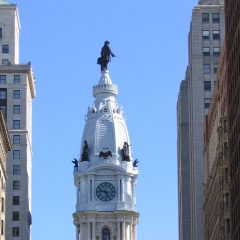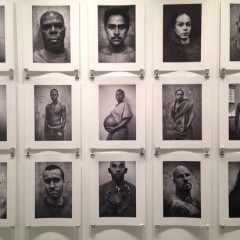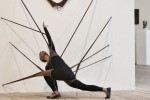I ran into Dread Scott in New York, which is how I learned that he’d done a work for Philadelphia’s Mural Arts Program. Dread Scott and Mural Arts? Scott describes himself as making revolutionary art to propel history forward.

His work has been discussed in books with titles such as Arresting Images: Impolitic Art and Uncivil Actions and Transgressions: The Offences of Art, which says something about its reception. Did Mural Arts really invite him to Philadelphia to create something other than a mural? Well, you wouldn’t know it from their website, but the piece is well-documented on Scott’s website, with documentation of the process and film interviews with the participants.
The project was part of Artworks!, a program of after-school workshops that Mural Arts runs in partnership with the Department of Human Services and involved Scott working with fourteen high school students during the summer of 2008. Scott said he learned from the students, and they learned from him. He had happy relations with Mural Arts despite the fact that he had to strike out a clause in the original contract that would have allowed the program to change the art if it provoked community outrage. He also negotiated the obvious difference in values, that the program’s priority was clearly pedagogy while his was to make art.
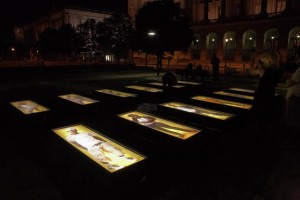
The piece was sited in May 2009 on the periphery of Logan Square and directly across the street from Family Court (a twin of the Free Library, one block to its East); the court’s juvenile division hears delinquency cases involving youth charged with misdemeanors or felonies. Approached from the side Scott’s installation might have been a series of solar panels mysteriously sited in the grass. But at closer range the dozen metal boxes clearly recall the rows of coffins laid out after a disaster. As I drew right up to them I could see the glossy, full-color and life-sized photographic portraits of urban youth, each in a box. One looked thoughtful, another self-confident, others seemed confused or wary.
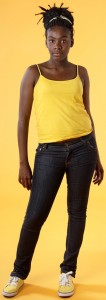
Then I heard voices near several boxes. Bending over to hear them over the din of the Vine Street Expressway I listened to the pictured teenagers tell of their neighborhoods and families; their incarcerated friends; of not fitting in and police who assume any black person on a street corner is dealing; of learning that art didn’t have to be painting; and of their aspirations: to go to college, to better themselves; several even wanted to be artists. Experiencing the piece made me stop and spend time listening to a group that normally feels neglected and ignored. The only other reason these students might be in this neighborhood is to appear before the court – as accused or as victims. They are the future of Philadelphia and they deserve to be heard. The message may be obvious, but it’s worth repeating.
The title of the piece, …Or does it explode? is taken from the last line of Langston Hughes’ poem Harlem which begins What happens to a dream deferred. The work was always intended to be out of doors for a finite time; the photographs weren’t made for that much sun. But the date has been extended to some time in November.
It’s a credit to Scott, his students and Mural Arts that the piece succeeds so well as art, and that anyone seeing it will care that these students’ dreams not be defered. It’s a credit to Mural Arts that they were willing to move beyond feel-good neighborhood murals and sponsor a piece that delivers a challenge rather than simple reassurance to its viewers. It’s also wonderful to see them taking chances with artists such as Scott.

Dread Scott will give a public lecture in November at Moore College; Artblog will post the date once it’s confirmed.
Visual Mashup
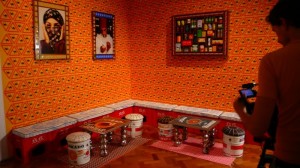
I got my first look at Hassan Hajjaj’s work this summer at the Victoria and Albert Museum, London, where he was in a small exhibition of finalists for the Jameel Prize. The new and substantial award (25,000 pounds Sterling) was offered for art in any form that draws upon Islamic craft and design. I’m glad I didn’t have to judge it because the finalists all produced interesting work but they were apples and oranges. How does one compare delicately-carved screen patterns cut into plastic which cast shadows on the wall (the winner) with posters in Arabic by a Dutch-trained designer or sculptural rings set with stones and decorated with engraving and micro-mosaic?
My favorite piece, hands down, was an environment by Hassan Hajjaj, Le Salon. The Moroccan-born Hajjaj (who lives in London and works as an artist and designer of clothes, interiors, record covers, etc.) created a fairly plausible Moroccan café decorated, as in many poor areas of the world, by recycling colorful product packaging that circulates as part of global commerce. I say “fairly plausible” because the entire space was clearly done by a trained eye and some of the ideas struck me as highly ironic. Within the sedate spaces of the V & A it burst forth with street smarts and the energy of international youth culture; I suspect it was too cheeky for the judges.
Everything was covered with branded, commercial patterns. The stools were made of large plastic paint buckets covered with fabric carrying the Louis Vuitton label (this is where I suspect the irony); the legs of the low tables were constructed of stacked metal teapots; the benches covered with rice sacks; picture-surrounds made of identical cigarette boxes, and (my favorite) the architectural, pierced-metal lanterns were made from food cans with their original printing still visible. The wallpaper is a repeat pattern of what I can only read as triangular warning signs for “camel crossing,” but this, too, may be a joke. Hajjaj’s cultural antecedents include Andy Warhol, Keith Haring and the anonymous designers of wax printed cotton made for the West African market (used by Yinka Shonibare) who can make patterns out of anything, including industrial material; I once saw a woman in D.C. whose dress was printed with life-size car radiators. In fact, Hajjaj sometimes incorporates these wax prints in his work. More of Hajjaj’s work can be seen at his website.
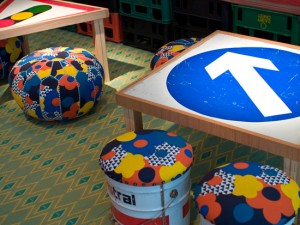
Imagine my surprise two days later when visiting relatives in Cardiff on finding that the environment had actually been commissioned by Chapter Art Centre, an alternative space that includes a cinema, gallery, theater, digital café, bar and shop in Cardiff’s very international immigrant neighborhood. Hajjaj assembled the café space in a vacant garage with help from neighborhood youth and it functioned as an actual café during May and June, 2009. Chapter’s staff emphasized that they considered the process of producing it to be the real piece, not the resulting environment. This sentiment sounds just like Mural Arts Program’s priorities. Another project that succeeds as pedagogy and as art.



